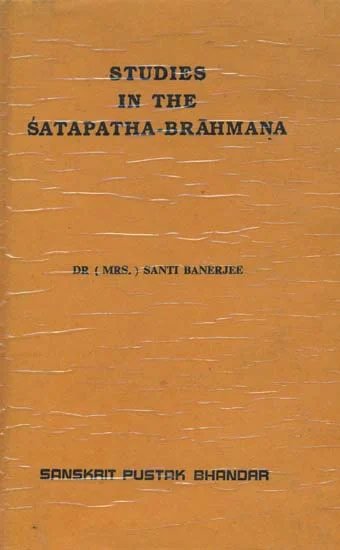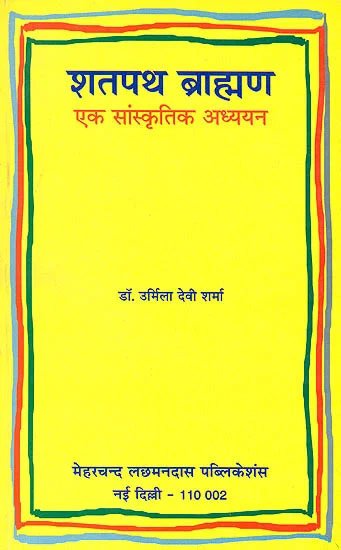Satapatha-brahmana [sanskrit]
147,532 words | ISBN-10: 812080113X | ISBN-13: 9788120801134
The Sanskrit text of the Satapatha-brahmana: One of the largest works in the category of Vedic (Brahmaic) literature, narrating in extensive detail the various rites, constructions, chants and utensils to be used in Hindu ceremonies. Alternative titles: Śatapathabrāhmaṇa (शतपथब्राह्मण), Śatapatha-brāhmaṇa (शतपथ-ब्राह्मण) Shatapathabrahma (shatapatha).
Verse 1.6.3.27
tadāhuḥ | kimidaṃ jāmi kriyate'gnīṣomayorevājyasyāgnīṣomayoḥ puroḍāśasya yadanantarhitaṃ tena jāmītyanena ha tvevājāmyājyasyetaram puroḍāśasyetaraṃ tadanyadivetaramanyadivetaram bhavatyṛcamanūcya juṣāṇena yajatyṛcamanūcyarcā yajati tadanyadivetaramanyadivetaram bhavatyanena ha tvevājāmyupāṃśvājyasya yajatyuccaiḥ puroḍāśasya sa yadupāṃśu tatprājāpatyaṃ rūpaṃ tasmāttasyānuṣṭubhamanuvākyāmanvāha vāgghyanuṣṭubvāgghi prajāpatiḥ
Preview of English translation:
27. On this point it has also been remarked: “Why this sameness (of performance)? By what is introduced between the butter(-offering) to Agni and Soma and the rice-cake to Agni and Soma, a repetition of performance (is committed).” Sameness (of performance), nevertheless, is avoided in this way: the one (viz. the low-voiced offering) consists of butter, and the other of a rice-cake, hence the one is different from the other. Moreover, after reciting a Rik-verse as anuvakya, he pronounces the yajya with the word 'pleased' (in the case of the butter-portions to Agni and Soma); and after reciting a Rik-verse as anuvakya, he pronounces the yajya in the form of a Rik-verse (in the case of the low-voiced offering to Agni and Soma), hence the one is (again) different from the other. Sameness of performance is also avoided in this way: in a low voice (he utters the formulas when) he offers of the butter, and with a loud voice of the cake; and what is (uttered) in a low voice, that is the manner of Prajapati: hence he recites for that (low-voiced offering) an anushtubh-verse as the invitatory formula (anuvakya), for the anushtubh represents speech, and Prajapati also is speech.
For a detailled translation, including proper diacritics and footnotes, go the full English translation.
Other editions:
Also see the following editions of the Sanskrit text or (alternative) English translations of the Satapatha-brahmana Verse 1.6.3.27
The Satapatha Brahmana (In Five Volumes)
by Julius Eggeling (1882)
2551 pages; [Publisher: Motilal Banarsidass Publishers Pvt. Ltd.]
Buy now!
The Satapatha Brahmana (3 volumes)
by Dr Jeet Ram Bhatt (2009)
Sanskrit Text with English Translation; 1726 pages; [Publisher: Eastern Book Linkers]; ISBN: 9788178541693
Buy now!
The Satapatha Brahmana (With The Commentary of Sayanacarya and Harisvamin)
by Rashtriya Sanskrit Sansthan (2002)
3483 pages; [शतपथ ब्राह्मणम्] According to the Madhyandina Recension; Commetaries: (1) Vedarthaprakash (Vedartha-prakasha) by Shrimat-Trayibhashyakar Sayanacharya, (2) Sarvavidyanidhana Kavindracharya Saraswati.
Buy now!
Studies in the Satapatha-Brahmana
by Dr. (Mrs.) Santi Banerjee (1993)
236 pages; [Publisher: Sanskrit Pustak Bhandar]
Buy now!
Cultural Study of the Satapatha Brahman (in Hindi)
by Dr. Urmila Devi Sharma (1982)
106 pages; Shatapatha Brahmana Ek Sanskritik Adhyan; [Publisher: Meharchand Lakshmandas Publications]
Buy now!![Satapatha-brahmana [sanskrit] - book cover](/uploads/a/NAC457-Satapatha-Brahmana.jpg)



